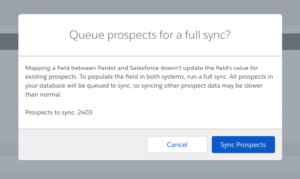Our favourites Pardot features of the year
There is no doubt that Pardot has delivered when it comes to new feature releases during 2018. We can also agree on that the new features this year have given a better user experience in Pardot and also touched on almost all the different functionalities that Pardot has. We all have our own personal favourite when it comes to the new releases. Read below why we chosen our favourite feature and click through to find out more about how you can use the feature.
Language Access
This feature was a really positive usability step for Pardot, and makes the platform a more feasible choice for users who have French, German, Spanish or Japanese as their first language.
It will be incredibly useful for SME’s outside the English speaking world, who would have struggled with the English language interface, and may have been missing out on all of Pardot’s great features.
This will be especially useful for global companies in helping improve user experience. If you want to enable this feature yourself, or deep dive into the new localised Trailhead you can find out more here.
Sophie – Pardot Consultant
Enabling Secure Tracker Domains
Sounds technical, but this feature simply enabled you to host your Pardot assets on a secure URL – so rather than http://go.example.com, you could use https://go.secure-example.com.
It was a great feature that finally ensured your web visitors had a seamlessly secure experience from your website to Pardot landing pages. But as https page status also became a more important quality indicator for search engine algorithms this year, it ensured your pages remained in the search listings.
An important feature to enable if you haven’t already, but read our advice here before you go full-steam ahead!
Nicola – Senior Pardot Consultant
Preview Email as a Prospect
Personalisation is key in email marketing and we can’t stress this enough. Customers expect to receive emails with relevant content and information targeted to their preferences or qualities. That is why one of my most likeable Pardot release feature is the Preview Email as a Prospect feature.
This function helps speed up the process of personalising your emails. It can help you save a lot of time by not needing to send yourself a test email. This also gives you confirmation that the dynamic information you are using in your emails are working in the right way. Read step-by-step how you can utilise this feature and about other new releases that happened this year here.
Linda – Digital Marketing Executive
Connected Campaigns
If I were to pick one word which the Pardot userbase finds the most confusing, it would certainly be ‘Campaign’. When the word ‘Campaign’ is mentioned, many Pardot users are talking about ‘Email Campaigns’, which is internal terminology rather than Pardot lexicon. Some users refer to ‘Pardot Campaigns’ and others to ‘Salesforce Campaigns’. This fragmentation of meaning certainly causes challenges for marketers looking to measure the effectiveness of their efforts.
This year’s release of Connected Campaigns gives us an opportunity to address this confusion by bringing alignment between Pardot Campaigns (used to track the first marketing touchpoint with a prospect), and Salesforce Campaigns (used to track the ongoing multiple marketing touchpoints with a Prospect). It makes us consider more carefully what a ‘Campaign’ actually is and how we report on our marketing efforts in both Pardot and Salesforce, whilst at the same time improving integration between Pardot and Salesforce, a trend we’ve seen accelerating in 2018.
This feature also adds particularly useful reporting functionality to Salesforce’s Campaign object, allowing engagement metrics for Pardot assets related to a Campaign to be seen from within Salesforce. If you’re interested in Connected Campaigns, we have a more detailed overview here.
Matt – Pardot Consultant
One-click Salesforce Full Sync
Until now, triggering a full sync between Salesforce and Pardot when creating a new customer field has involved either a tedious manual process or waiting days for Pardot Support.
However, Pardot have released this excellent timesaver which runs a full sync with just one click. The option pops up after your create or edit a Pardot custom field. This reduces the need for unnecessary automations or risky CSV exports of your entire database. One thing to note is that this only works for databases up to 500,000 prospects. For larger databases, you’ll still need to contact Pardot Support to trigger a full sync.
for unnecessary automations or risky CSV exports of your entire database. One thing to note is that this only works for databases up to 500,000 prospects. For larger databases, you’ll still need to contact Pardot Support to trigger a full sync.
I think this is a fabulous example of Pardot listening to feedback and aiming its updates at freeing up marketers’ time to focus on powerful, targeted campaigns rather than time-consuming back-end processes.
Sarah – Head of Pardot
Copy and Paste steps in Engagement Studio
Pardot rolled out plenty of new releases related to Engagement Studio over the year, but one of my favourite new feature is copying and pasting steps in the nurture program.
By copying a set of existing actions, triggers and rules (up to 10 steps in total) we can build the skeleton of a complex nurture program faster and more efficient. But use it with caution and ensure the correct Pardot assets are placed at the relevant step of the user journey; best might be to copy general or placeholder steps only.
Marketing specialists will love this feature, as well as other new areas of Engagement Studio that were also released as part of the Winter Release ‘19. Read more about them here.
Dori – Pardot Consultant
